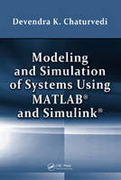
Modeling and simulation of systems using MATLAB and Simulink
Chaturvedi, Devendra K.
This text provides comprehensive, state-of-the-art coverage of all the important aspects of modeling and simulating both physical and conceptual systems. Various real-life examples show how simulation plays a key role in understanding real-world systems. The author presents a step-by-step procedure for modeling using top-down, bottom-up, and middle-out approaches. He develops models forcomplex systems and reduces their order so they can be applied effectively inonline applications. He also uses soft computing techniques for modeling nonlinear, ill-defined, and complex systems. The accompanying CD-ROM includes simulation code in MATLAB and Simulink registered. INDICE: Introduction to Systems System Classification of Systems Linear Systems Time-Varying vs. Time-Invariant Systems Lumped vs. Distributed ParameterSystems Continuous- and Discrete-Time Systems Deterministic vs. Stochastic Systems Hard and Soft Systems Analysis of Systems Synthesis of Systems Introduction to System Philosophy System Thinking Large and Complex Applied System Engineering: A Generic Modeling Systems Modeling Introduction Need of System Modeling Modeling Methods for Complex Systems Classification of Models Characteristics of Models Modeling Mathematical Modeling of Physical Systems Formulation of State Space Model of Systems Physical Systems Theory System Components and Interconnections Computation of Parameters of a Component Single Port and Multiport Systems Techniques of System Analysis Basics of Linear Graph Theoretic Approach Formulation of System Model for Conceptual System Formulation System Model for Physical Systems Topological Restrictions Development of State Model of Degenerative System Solution of State Equations Controllability Observability Sensitivity Liapunov Stability Performance Characteristics of Linear Time Invariant Systems Formulation of State Space Model Using Computer Program (SYSMO) Model Order Reduction Introduction Difference between Model Simplification and Model Order Reduction Need for Model Order Reduction Principle of Model Order Reduction Methods of Model Order Reduction Applications of Reduced-Order Models Analogous of Linear Systems Introduction Force--Voltage (f--v) Analogy Force--Current (f--i) Analogy Interpretive Structural Modeling Introduction Graph Theory Interpretive Structural Modeling System Dynamics Techniques Introduction System Dynamics of Managerial and Socioeconomic System Traditional Management Sources of Information Strength of System Dynamics Experimental Approach to System Analysis System Dynamics Technique Structure of a System Dynamic Model Basic Structure of System Dynamics Models Different Types of Equations Used in System Dynamics Techniques Symbol Used in Flow Diagrams Dynamo Equations Modeling and Simulation of Parachute Deceleration Device Modeling of Heat Generated in a Parachute during Deployment Modeling of Stanchion System of Aircraft Arrester Barrier System Simulation Introduction Advantages of Simulation When to Use Simulations Simulation Provides How Simulations Improve Analysis and Decision Making Applications of Simulation Numerical Methods for Simulation The Characteristics of Numerical Methods Comparison of Different Numerical MethodsErrors during Simulation with Numerical Methods Nonlinear and Chaotic SystemsIntroduction Linear vs. Nonlinear System Types of Nonlinearities Nonlinearities in Flight Control of Aircraft Conclusions Introduction to Chaotic System Historical Prospective First-Order Continuous-Time System Bifurcations Second-Order System Third-Order System Modeling with Artificial Neural Network Introduction Artificial Neural Networks Modeling Using Fuzzy Systems Introduction Fuzzy Sets Features of Fuzzy Sets Operations on Fuzzy Sets Characteristics of Fuzzy Sets Properties of Fuzzy Sets Fuzzy Cartesian Product Fuzzy Relation Approximate Reasoning Defuzzification Methods Introduction to Fuzzy Rule--Based Systems Applications of Fuzzy Systems to System Modeling Takagi--Sugeno--Kang FuzzyModels Adaptive Neuro-Fuzzy Inferencing Systems Steady State DC Machine ModelTransient Model of a DC Machine Fuzzy System Applications for Operations Research Discrete-Event Modeling and Simulation Introduction Some Important Definitions Queuing System Discrete-Event System Simulation Components of Discrete-Event System Simulation Input Data Modeling Family of Distributions for Input Data Random Number Generation Chi-Square Test Kolomogrov--Smirnov Test AppendixA: MATLAB Appendix B: Simulink Appendix C: Glossary Index.
- ISBN: 978-1-4398-0672-2
- Editorial: CRC Press
- Encuadernacion: Tela
- Páginas: 709
- Fecha Publicación: 21/12/2009
- Nº Volúmenes: 1
- Idioma: Inglés
